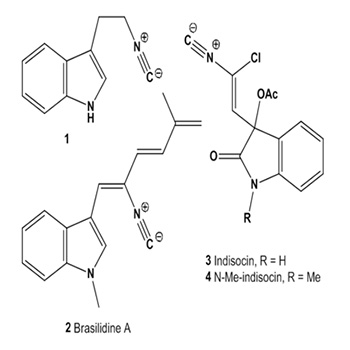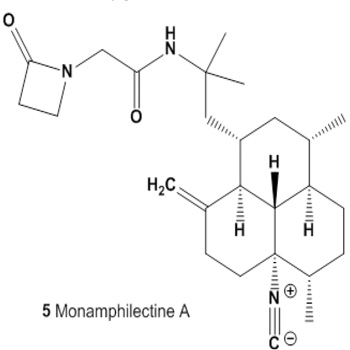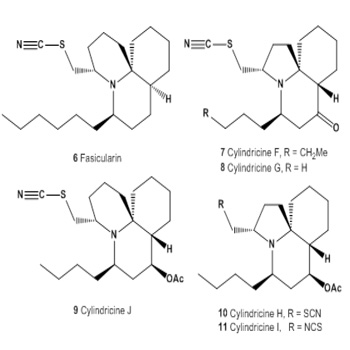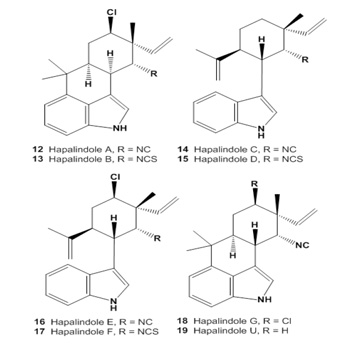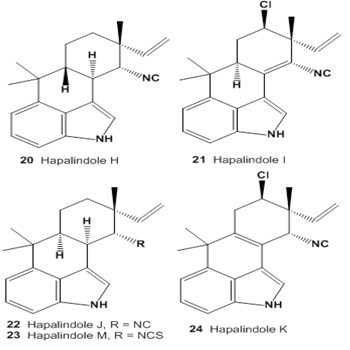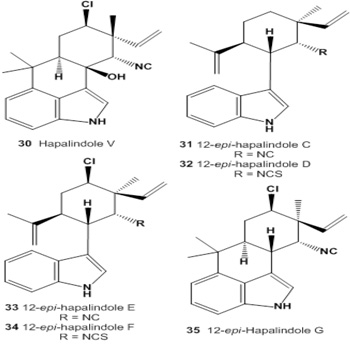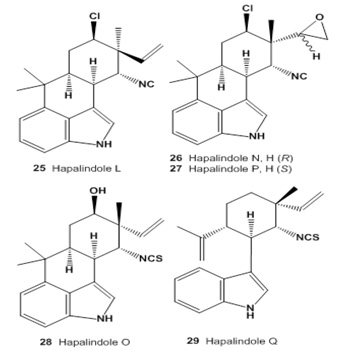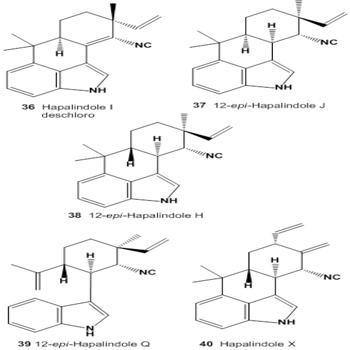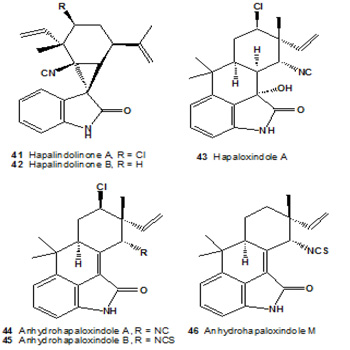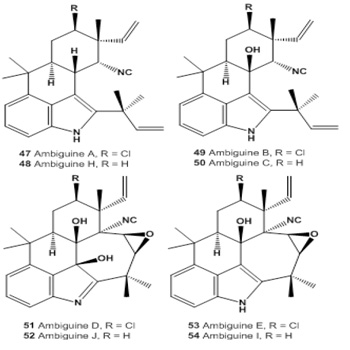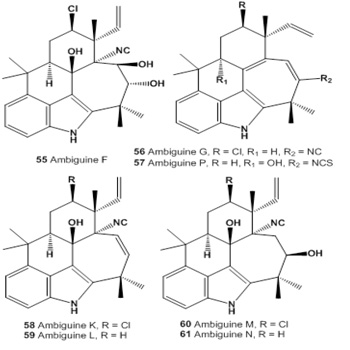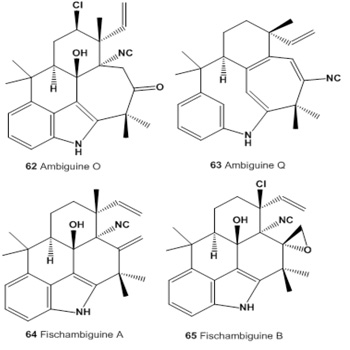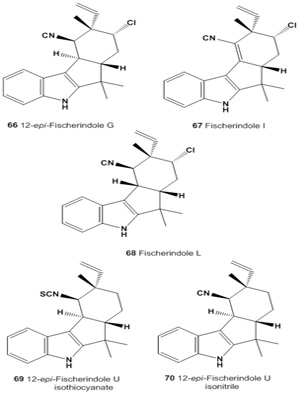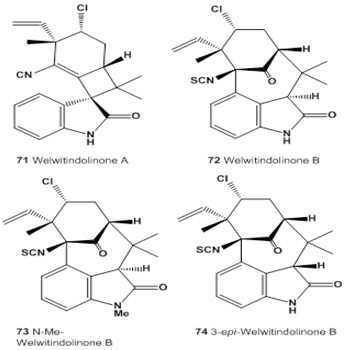Previous Issues Volume 1, Issue 1 - 2016
Naturally Occurring Isocyano/Isothiocyanato Compounds: Their Pharmacological and SAR Activities
Dmitri O Levitsky1 , Tatyana A Gloriozova2 , Vladimir V Poroikov2 , Valery M Dembitsky3
1CNRS UMR 6204, Biotechnologie, Biocatalyse et Bioregulation, Faculty des Sciences et des Techniques, University de Nantes Nantes, 44322 Nantes Cedex 03, France. 2Institute of Biomedical Chemistry, Moscow 119121, Russia. 3Institute for Drug Discovery, P.O. Box 45289, Jerusalem 91451, Israel. Corresponding Author:Valery M. Dembitsky, Institute for Drug Discovery, 8 Ha-Marpe Str, P.O. Box 45289, Jerusalem 91451, Israel, Tel: +972-526877444; E-Mail: [email protected] Received Date: 27 Feb 2016 Accepted Date: 08 Mar 2016 Published Date: 18 Mar 2016 Copyright © 2016 Dembitsky VM Citation: Levitsky DO, Gloriozova TA, Poroikov VV and Dembitsky VM. (2016). Naturally Occurring Isocyano/ Isothiocyanato Compounds: Their Pharmacological and SAR Activities. Mathews J Pharm Sci. 1(1): 003 ABSTRACT:
Rapid and accurate identification of microorganisms is an essential part of pharmaceutical analysis. Contaminants found in ingredients, water for pharmaceutical use, the manufacturing environment, intermediates, and finished products are identified to assist in product investigations. There are number of phenotypic, genotypic and proteotypic methods. A comparison of the database size of representative methods, as well as accuracy of these systems is presented in the review. Emphasis is given to the features of methods and factors affecting the result of identification. Some species of microorganisms within one genus, which determination is problematic from both a genotypic and a phenotypic perspective, are discussed in details. Validation of identification methods is the most important and challenging part of proper automated system choice. Approaches to the evaluation of the system are highlighted in the review. ABBREVIATIONS:
The MIC (minimum inhibitory concentration) is the lowest concentration of an antimicrobial that will inhibit the visible growth of a microorganism after overnight incubation. Pa and Pi value tells the probability of activity. Pa means probability to be active and Pi means probability to be inactive. The IC50 is a measure of how effective a drug is. It indicates how much of a particular drug or other substance is needed to inhibit a given biological process (or component of a process, i.e. an enzyme, cell, cell receptor or microorganism) by half.
INTRODUCTION:
Isocyano/isothiocyanato compounds are a rare group of biological active products with limiting occurrence in nature [1,2]. They play an important role in the secondary metabolism of cyanobacteria and other microorganisms [1-6]. More than three and a half thousand strains of cyanobacteria have been studied, resulting in the description of more than one thousand secondary compounds, including more than two hundred alkaloids, and other bioactive metabolites [7-19]. Many of these alkaloids possess diverse pharmacological activities, such as antibacterial, antimalarial, antifouling, and anti-algal activities. These alkaloids apparently function via isocyanide (-N=C), isothiocyanate (-N=C=S) and/or thiocyanate (-S-C=N) group(s). Isothiocyanates have been identified as preferred active constituents of several cyanobacterial families, and some microorganisms. Isothiocyanates suppress tumor cells growth by generating reactive oxygen species or by inducing cycle arrest leading to apoptosis [20-22]. Compounds containing the isocyano group include notably natural alkaloids, and the first isocyanide, xanthocilin was obtained from fermentation broth of the fungus Penicilliumnotatum as early as in 1948 [23-25]. Similar metabolites containing a thiocyanate moiety have recently been isolated, and a few thiocyanate alkaloids have recently been discovered [26-28]. Several reviews on naturally occurring isocyano/ isothiocyano/ thiocyano natural products and related compounds from both marine and terrestrial sources have been published [1, 6, 24, 29-35]. Using the SAR (Structure-Activity Relationships) approach realized in computer program PASS, some additional activities were also predicted, which indicates new possible applications for these compounds. This article emphasizes the role of isocyano/isothiocyanato and thiocyanato compounds as significant sources of leads for drug discovery. The surprising results refine the current understanding of the interplay between the chemical structure and activities. Prediction of Novel and Additional Pharmacological Activities:
Bearing in mind that the above data on the biological activity of isocyano/isothiocyanato compounds and their analogues characterized only a small part of the possible biological potential in these molecules, we estimated their biological activity spectra using a computer prediction (Table 1). Computer program PASS (Prediction of Activity Spectra for Substances) estimates the probable biological activity profiles for compounds based on their structural formulae in MOL file or SD file formats [36-39]. A general list of predictable biological activities consists of over 7,000 terms including pharmaco-therapeutic effects (e.g., antiarrhythmic), biochemical mechanisms (e.g., cyclooxygenase 1 inhibitor), toxicity (e.g., carcinogenic), metabolism (e.g., CYP3A4 inhibition), gene expression regulation (e.g., VEGF expression inhibition), and transporter-related activities (e.g., P-glycoprotein substrate). PASS prediction is based on information of the structure-activity relationships in more than 900,000 compounds with known biological activities. The average prediction accuracy estimated in a leaveone- out cross-validation procedure for the entire PASS training set is approximately 95% [40]. For each activity, Pa and Pi values are calculated and can be interpreted either as the probabilities of a molecule belonging to the classes of active and inactive compounds, respectively, or as the probabilities of the first and second types of errors in prediction. The robustness of the PASS algorithm has been shown in special experiments with principal compounds from an MDDR database consisting of 18,977 compounds with 124 activities. The set of compounds was divided 50 times at random into two equal subsets. The first subset was used as the training set, the second as the evaluation subset and vice versa (100 experiments). 20, 40, 60, or 80% of the information (activity/ structure data) was randomly excluded from the training set. The average accuracy of prediction (IAP) was calculated for each type of activity. Despite the removal of up to 60% of the information, PASS continued to provide reasonable prediction accuracy [41]. The interpretation of the prediction results and the selection of the most promising compounds are based on flexible criteria that depend on the purpose of the particular investigation. If the user chooses a higher value of Pa as a threshold for the selection of probable activities, the chance to confirm the predicted activities by the experiment is also high; however, many activities will be lost. For instance, if Pa > 80% is used as a threshold, approximately 80% of the real activities will be lost; for Pa > 70%, the portion of lost activities is 70%, etc. By default, the Pa > Pi value determined at the training is used as a threshold that provides a mean accuracy 95%. The average accuracy of the PASS predictions obtained for the heterogeneous evaluation set was nearly 90% [42-44]. Therefore, isocyano/isothiocyanato compounds can be used as a source for selecting hits in many different pharmacotherapeutic areas. In the further application of a SOSA (Selective Optimization of Side Activities) approach [45], desirable activities can be increased and unwanted activities can be reduced. Although the majority of the known biological activities for respective isocyano/ isothiocyanato alkaloids are associated with antineoplastic action, their number is less than 60% (51/80) among the predicted focal activities. A computer analysis of the predicted biological activity spectra showed that 58 types of biological activity are predicted with Pa > 70%, 199 with Pa > 50%, 463 with Pa > 30%, and 810 with Pa > Pi.
Rare and Unusual Compounds:
Compound (1), 3-(2-isocyanoethyl)-1H-indole, is produced by Streptomyces species [46]. An unusual indole alkaloid with cytotoxic activity, named brasilidine A (2) has been isolated from the actinomycete Nocardia brasiliensis IFM 0089 [47]. Two antibiotics, indisocin (3) and N-methylindisocin (4), were isolated from the soil culture filtrate of Nocardia blackwellii MG323-hF2, which was collected at Shinagawa-ku (Tokyo, Japan) [48]. Both compounds showed antibacterial and antifungal activities against Bacillus anthracis, Bacillus cereus ATCC 10702, Bacillus subtilis NRRL B-558, B. subtilis PCI 219, Corynebacterium bovis 1810, Micrococcus luteus FDA 16, Micrococcus luteus FDA 1001, Staphylococcus aureus 209P, S. aureus MS8710, S. aureus MS8610, S. aureus Smith, Escherichia coli K-12, E. coli ML 1629, E. coli NTHJ, Klebsiella pneumonia PCI 602, Proteus rettgeri GN311, P. rettgeri GN466, P. vulgaris OX19, Salmonella enteritidis, Salmonella typhi T-63, Serratia marcescens, Shigella dysenteriae JS11910, S. flexneri 4bJS11811, S. sonnei JS11746, and Mycobacterium smegmatis ATCC 607 [49].
Diterpenoid β-lactam alkaloid, monamphilectine A (5), show ing potent antimalarial activity, was isolated from the Puerto Rican marine sponge Hymeniacidon sp. [50]. This alkaloid (5) demonstrated activity against a chloroquine-resistant protozoan parasite Plasmodium falciparum W2 strain at IC50 values of 0.60 μM. Monamphilectine A (5) possesses also the bactericidal action against Mycobacterium tuberculosis H37Rv, MIC value of 15.3 μg/mL [50].
The tricyclic alkaloid, fasicularin (6) with cytotoxic properties against a DNA repair-deficient strain of yeast, as well as, cytotoxicity against Vero cells [30], was isolated from the ascidian Neptheis fascicularis collected in Pohnpei (Micronesia) [41,42].
Several structurally related tricyclic alkaloids, e.g., cylindricines F (7), G (8), J (9), H (10) and I (11) produced by the marine ascidian Clavelina cylindrica from Tasmania [53-55]. Cylindricine C (TKGP-100213) has showed the growth inhibition of human solid tumor cell lines [56]. Activities of compounds 1-11 are shown in Table 1.
Table 1: Confirmed pharmacological and probable new activities
|
No |
Activity reviewed |
Activities confirmed (Pa) |
Additional predicted activities (Pa*) |
|---|---|---|---|
|
1 |
Not studied |
- |
Antineurotoxic (0,773) Antineoplastic (0,718) |
|
2 |
Cytotoxic |
Antineoplastic (0,873) |
Antacid (0,655) Gastric secretion stimulant (0,560) |
|
3 |
Antifungal Antibacterial |
Antifungal (0,657) Antibacterial (0,572) |
Antineoplastic (0,538) |
|
4 |
Antifungal Antibacterial |
Antifungal (0,585) Antibacterial (0,546) |
Antineoplastic (0,526) |
|
5 |
Antimalarial Anti-mycobacterial |
Antiprotozoal (Plasmodium) (0,938) Antiprotozoal (0,937) |
Antieczematic (0,682) Antiosteoporotic (0,626) Bone diseases treatment (0,578) |
|
6 |
Cytotoxic |
Antineoplastic (0,734) |
Cardiotonic (0,882) Antiarrhythmic (0,866) Nootropic (0,839) |
|
7 |
Antineoplastic (solid tumors) |
Antineoplastic (0,716) |
Cardiotonic (0,824) Antiarrhythmic (0,784) Antiischemic, cerebral(0,555) |
|
8 |
Antineoplastic (solid tumors) |
Antineoplastic (0,715) |
Cardiotonic (0,834) Antiarrhythmic (0,801) Antiischemic, cerebral (0,522) |
|
9 |
Antineoplastic (solid tumors) |
Antineoplastic (0,769) |
Cardiotonic (0,856) Antiarrhythmic (0,822) Nootropic (0,634) |
|
10 |
Antineoplastic (solid tumors) |
Antineoplastic (0,769) |
Cardiotonic (0,856) Antiarrhythmic (0,822) Nootropic (0,634) |
|
11 |
Antineoplastic (solid tumors) |
Antineoplastic (0,838) Apoptosis agonist (0,794) |
Cardiotonic (0,882) Antiarrhythmic (0,845) Chemoprotective (0,562) |
*Activities with Pa > 0.5 are only shown.
Alkaloids of the Hapalindole Family:
More than 30 years ago, Moore and co-workers isolated of alkaloids from soil cyanobacteria, that belong to the familiesambiguines, fischerindoles, hapalindoles, welwitindolinones, hapalindolinones, hapaloxindo-les, and fontonamides [57].
Several hapalindoles and welwitindolinones have showed insecticidal activity [58,59]. Reports have surfaced of anti-algal activity from the hapalindoles, anti-mycotic activity from the hapalindoles, welwitindolinones, and ambiguines and antibacterial activity from the hapalindoles and ambiguines [7,8,57,60-65]. Furthermore, hapalindolinone A inhibits arginine vasopressin binding [66]. The welwitindolinones have showed an anticancer activity against multiple drug-resistant ovarian cancer cell lines [59,67,68].
The antibacterial agents hapalindoles A (12), B (13), C (14), D (15), E (16), F (17), G (18), H (20) and I (21) were prepared by culturing the cyanobacterium Hapalosiphon fontinalis ATCC 39694 (Stigonemataceae) [69].
All obtained indole alkaloids showed antibacterial activity against Staphylococcus aureus X1.1, S. aureus V41, S. aureus X400, S. aureus S13E, S. epidermidis EPI1, S. epidermidis 222, S. pyogenes C203, S. pneumoniae Park 1, S. faecium ATCC 9790, Streptococcus sp. group D 2041, Haemophilus influenzae C.L., H. influenzae 76, E. coli N10, E. coli EC14, E. coli TEM, Klebsiella pneumoniae X26, K. pneumoniae X68, K. pneumoniae KAE, Salmonella sp. X514, Shigella sonnei N9, Proteus morganii PR15, and Acinetobacter calcoaceticus AC12.
The antifungal agents hapalindoles A (12), C (14), E (16), G (18) and H (20) obtained from culturing the cyanobacterium Hapalosiphonfontinalis ATCC 39694 (Stigonemataceae) showed in vivo activity against Candida albicans and Trichophyton mentagrophytes [69].
Cultured Westiellopsis sp. SAG 20.93 and Fischerella muscicola UTEX LB1829 cyanobacteria led to the isolation of several alkaloids, namely deschlorohapalindole I (36), hapalindole X (40) andother indole alkaloids: hapalindoles(12), C (14), G (18), H (20), I (21), J (22), U (19), anhydrohapaloxindole A (44), and fischerindole L (68) [70].
All examined compounds exhibited weak to moderate cytotoxicity against HT-29, MCF-7, NCI-H460, SF268, and IMR90 cells. The hapalindole X (40) and A (12) and hapalonamide H (20) have showed activity against both M. tuberculosis and C.albicans, MIC values at 0.6 to 2.5 μM, respectively [71]. As antibacterial and antifungal agents, indole alkaloids, known as hapalindoles J (22), K (24), L (25), M (23), N (26), O (28), P (27), Q (29), U (19) and V (30), were prepared by cyanobacterium Hapalosiphon fontinalis ATCC 39694 [72]. Isolated alkaloids demonstrated antibacterial and antifungal activities against Staphylococcus aureus X1.l, Bacillus subtilis X12, Micrococcus luteus X186, Streptococcus pneumoniae X647, Proteus vulgaris X45, Salmonella gallinarum X142, E. coli X161, E. coliX580, Saccharomyces pastorianus X52, Neurospora crassa X846, and Candida albicans X657 [72].
Freshwater cyanobacterium Fischerella ATCC 43239 have produced of 12-epi-hapalindole C isonitrile (31), 12-epi-hapalindole E isonitrile (33), 12-epi-hapalindole J isonitrile (37), and hapalindole L (25). Compounds 25, 31 and 33 have showed insecticidal activities [58].
The alkaloids 12-epi-hapalindole E isonitrile (33), isolated from the cyanobacterium Fischerella sp., and the indolophenanthridinecalothrixin A from Calothrix sp., were characterized in terms of their ability to kill several organisms and cell types and their biochemical modes of action. Both compounds inhibited RNA synthesis, and consequently protein synthesis, in Bacillus subtilis.
Calothrixin A also inhibited DNA replication, the hapalindole having little effect on this process. Measurements of in vitro RNA synthesis confirmed the in vivo results and suggested that both compounds inhibit RNA polymerase directly; the degree of inhibition was independent of the DNA concentration but strongly dependent on the polymerase concentration [64]. Activities of compounds belonging to the hapalindole family are shown in Table 2.
Table 2:Confirmed pharmacological and SAR activities.
|
No |
Activity reviewed |
Activities confirmed (Pa) |
Additional predicted activities (Pa*) |
|---|---|---|---|
|
12 |
Antibacterial Antifungal Antituberculosic Cytotoxic |
Antibacterial (0,487) Antifungal (0,535) Antimycobacterial (0,503) Antineoplastic(0,749) |
Anti-Plasmodium (0,589) Urolithiasis treatment (0,587) Antiprotozoal (0,532) |
|
13 |
Antibacterial |
Antibacterial (0,383) |
Antineoplastic (0,693) Antifungal (0,531) |
|
14 |
Antibacterial Antifungal Cytotoxic |
Antibacterial (0,312) Antifungal (0,436) Antineoplastic(0,696) |
Antieczematic (0,693) Urolithiasis treat-t (0,630) Psychostimulant (0,546) |
|
15 |
Antibacterial |
Antibacterial (0,194) |
Apoptosis agonist (0,631) Antieczematic (0,641) Antineoplastic (0,613) |
|
16 |
Antibacterial Antifungal |
Antibacterial (0,385) Antifungal (0,485) |
Urolithiasis treatment (0,757) Antineoplastic (0,735) Antieczematic (0,568) |
|
17 |
Antibacterial |
Antibacterial (0,268) |
Urolithiasis treat-t (0,723) Antineoplastic (0,679) Apoptosis agonist (0,552) |
|
18 |
Antibacterial Antifungal Cytotoxic |
Antibacterial (0,487) Antifungal (0,535) Antineoplastic(0,749) |
Antiprotozoal (0,729) Antiprotozoal (0,699) Antieczematic (0,530) |
|
19 |
Antibacterial Antifungal Cytotoxic |
Antibacterial (0,357) Antifungal (0,394) Antineoplastic (0,709) |
Anti-Plasmodium (0,729) Antiprotozoal (0,699) Antieczematic (0,530) |
|
20 |
Antibacterial Antifungal Antituberculosic |
Antibacterial (0,357) Antifungal (0,394) Antineoplastic (0,709) |
Anti-Plasmodium (0,729) Antiprotozoal (0,699) Antieczematic (0,530) |
|
21 |
Antibacterial Cytotoxic |
Antibacterial (0,487) Antineoplastic(0,749) |
Anti-Plasmodium (0,589) Urolithiasis treat-t (0,587) Antifungal (0,535) |
|
22 |
Antibacterial Antifungal Cytotoxic |
Antibacterial (0,357) Antifungal (0,394) Antineoplastic(0,709) |
Anti-Plasmodium (0,729) Antiprotozoal (0,699) Antieczematic (0,530) |
|
23 |
Antibacterial Antifungal |
Antibacterial (0,240) Antifungal (0,390) |
Antineoplastic (0,628) Apoptosis agonist (0,508) |
|
24 |
Antibacterial Antifungal |
Antibacterial (0,447) Antifungal (0,275) |
Antineoplastic (0,852) Antiinflammatory (0,710) |
|
25 |
Antibacterial Antifungal |
Antibacterial (0,487) Antifungal (0,535) |
Antineoplastic (0,749) Anti-Plasmodium (0,589) |
|
26 |
Antibacterial Antifungal |
Antibacterial (0,285) Antifungal (0,326) |
Antineoplastic (0,670) Urolithiasis treatment (0,582) |
|
27 |
Antibacterial Antifungal |
Antibacterial (0,285) Antifungal (0,326) |
Antineoplastic (0,670) Urolithiasis treat-t (0,582) |
|
28 |
Antibacterial Antifungal |
Antibacterial (0,392) Antifungal (0,542) |
Antineoplastic (0,705) Apoptosis agonist (0,571) |
|
29 |
Antibacterial Antifungal |
Antibacterial (0,194) Antifungal (0,431) |
Apoptosis agonist (0,631) Antieczematic (0,641) |
|
30 |
Antibacterial Antifungal |
Antibacterial (0,548) Antifungal (0,594) |
Antineoplastic (0,810) Urolithiasis treat-t (0,601) |
|
31 |
Insecticide |
- |
Anti-Plasmodium (0,759) Antineoplastic (0,696) |
|
32 |
Not studied |
- |
Apoptosis agonist (0,631) Antieczematic (0,641) |
|
33 |
Insecticide RNA inhibitor |
- |
Urolithiasis treat-t (0,757) Antineoplastic (0,735) Antiprotozoal (0,610) |
|
34 |
Not studied |
- |
Antineoplastic (0,679) Apoptosis agonist (0,552) |
|
35 |
Not studied |
- |
Antineoplastic (0,749) Anti-Plasmodium (0,589) |
|
36 |
Not studied |
- |
Antineoplastic (0,743) Antiallergic (0,740) |
|
37 |
Insecticide |
- |
Antineoplastic (0,709) Antiprotozoal (0,699) |
|
38 |
Not studied |
- |
Antineoplastic (0,709) Antiprotozoal (0,699) |
|
39 |
Not studied |
- |
Antiprotozoal (0,745) Antineoplastic (0,696) |
|
40 |
Anti-mycobacterial |
Antimycobacterial (0,309) |
Antieczematic (0,771) Antipsoriatic (0,747) Antineoplastic (0,712) |
|
41 |
Vasopressin antagonist |
- |
Anti-Plasmodium(0,823) Antiprotozoal (0,813) |
|
42 |
Vasopressin antagonist |
Kidney function stimulant (0,279) |
Anti-Plasmodium(0,823) Antiprotozoal (0,813) |
|
43 |
Not studied |
- |
Antineoplastic (0,803) Antibacterial (0,630) |
|
44 |
Not studied |
- |
Antineoplastic (0,807) Urolithiasis treat-t (0,573) |
|
45 |
Not studied |
- |
Antineoplastic (0,763) Apoptosis agonist (0,529) |
|
46 |
Not studied |
- |
Antineoplastic (0,730) Apoptosis agonist (0,620) |
AmbiguineA (47), B (49), C (50), D (51), E (53), I (54) and F (55) demonstrated antifungal activity against Candida albicans, Trichophyton mentagrophytes, and Aspergillus fumigatus[ 72]. Ambiguine A (47), C (50), D (51), E (53) and I (54) have showed anticancer activity against L1210 (murine leukemia cell line), P03 (murine pancreatic tumor cell line), C38 (murine colon tumor cell line), Maml7 (murine mammary tumor cell line), CX -1, H8 (both human colon tumor cell line) and LML (low-malignant L cells) [72]. In the terrestrial cyannobacterium Hapalosiphon delicatulus UH IC-13-1) has been found an ambiguine G nitrile [30].
Cultured cyanobacterium Fischerella sp. yielded alkaloids which contained isonitrile moiety. Ambiguine A isonitrile (47), ambiguine H isonitrile (48), ambiguine B isonitrile (49), ambiguine D isonitrile (51), ambiguine E isonitrile (53), ambiguine J isonitrile (52), ambiguine I isonitrile (54), and 12-epi-hapalindole H (38) have been isolated from Fischerella ambigua. Ambiguine H isonirile (48) and ambiguine I isonirile (54) possessed antibacterial and anti-mycotic activities [62].
Several indole alkaloids were isolated from the cultured cyanobacteria Hapalosiphon laingii. Those include 12-epihapalindole C isonitrile (31), 12-epi-hapalindole E isonitrile (33), 12-epi-hapalindole G isonitrile (35), 12-epi-hapalindole H isonitrile (38), 12-epi-hapalindole Q isonitrile (39), in addition to the known metabolites hapalindolinones A (41) and B (42) [61].
The compounds (41) and (42) are antagonists of vasopressin. Vasopressin antagonists were useful in the treatment and prevention of renal and cardiovascular disorders [66]. Anhydrohapaloxindoles A (44) B (45) and M (46) and hapalonamides G (18), H (20), and V (30) have been isolated as minor indole alkaloids from a cultured strain of the terrestrial cyanobacteria Hapalosiphon fontinalis[7,73]. Antibacterial ambiguineK (58), L (59), M (60), N (61) and O (62) isonitriles and previously described indole alkaloids ambiguine A (47), B (49), C (50), E (53), F (55), and I (54) isonitriles and hapalindole G (18) and H (20) were isolated from the cyanobacterium F. ambigua UTEX 1903 via bioassay-guided fractionation.
Two ambiguine K (58) and M (60) isonitriles have showed the most potent activity against Mycobacterium tuberculosis, with MIC values of 6.6 and 7.5 μM, respectively. Although ambiguine Aisonitrile (47) has showed activity against B. anthracis, MIC of 1.0 μM.
Ambiguine K isonitrile (58) was active against Mycobacterium tuberculosis, MIC 6.6 μM. Ambiguine A isonitrile (47) has showed activity against Bacillus anthracis, MIC of 1.0 μM, similar to ambiguine K (58), L (59) M (60), N (61), and O (62) isonitriles [74]. Most ambiguine isonitrile and hapalindole alkaloids possessed strong antifungal activities and only moderately toxic in a Vero cell assay (IC50 26.0 to 120 μM). Hapalindole- related alkaloids, namely ambiguine G (56), ambiguine P (57), ambiguine Q (63) nitriles, and fischambiguines A (64) and B (65) have been found in extracts of the cultured cyanobacterium Fischerella ambigua UTEX 1903. Fischambiguine B has been displayed strong inhibitory activity against Mycobacterium tuberculosis, MIC value of 2 μM [74]. Activities of compounds belonging to the ambiguine family are shown in Table 3.
Table 3: Confirmed pharmacological and SAR activities.
|
No |
Activity reviewed |
Activities confirmed (Pa) |
Additional predicted activities (Pa*) |
|---|---|---|---|
|
47 |
Antifungal Antineoplastic |
Antifungal (0,415) Antineoplastic (0,803) |
Anti-Plasmodium (0,532) Antibacterial (0,516) |
|
48 |
rAianltibacte- bAanctit-emriyaclo |
Antibacterial (0,394) (A0n,1ti6m5y)cobacterial |
Antineoplastic (0,781) Antiprotozoal (0,645) Antieczematic (0,575) |
|
49 |
Antifungal |
Antifungal (0,527) |
Antineoplastic (0,851) Antimitotic (0,563) |
|
50 |
Antifungal Antineoplastic |
Antifungal (0,384) Antineoplastic (0,838) |
Antimitotic (0,629) Anti-Plasmodium (0,545) Antieczematic (0,573) |
|
51 |
Antifungal Antineoplastic |
Antifungal (0,779) Antineoplastic (0,847) |
Antimycobacterial (0,881) Antibacterial (0,704) Urolithiasis treatment (0,615) |
|
52 |
Not studied |
- |
Antineoplastic (0,849) Anti-Plasmodium (0,765) Antiprotozoal (0,731) Antifungal (0,692) |
|
53 |
Antifungal Antineoplastic |
Antifungal (0,786) Antineoplastic (0,826) |
Antimycobacterial (0,917) Antibacterial (0,705) |
|
54 |
Antifungal Antineoplastic Antibacterial |
Antifungal (0,701) Antineoplastic (0,826) Antibacterial (0,615) |
Antiprotozoal (Plasmodium) (0,679) Antiprotozoal (0,617) |
|
55 |
Antifungal |
Antifungal (0,803) |
Antimycobacterial (0,931) Antineoplastic (0,845) Antibacterial (0,737) |
|
56 |
Not studied |
- |
Antineoplastic (0,805) Antimycobacterial (0,592) |
|
57 |
Not studied |
- |
Antineoplastic (0,726) Antipsoriatic (0,563) Antischistosomal (0,526) |
|
58 |
Antibacterial Anti-mycobacterial |
Antibacterial (0,765) Antimycobacterial (0,960) |
Antifungal (0,823) Antineoplastic (0,811) |
|
59 |
Antibacterial |
Antibacterial (0,686) |
Antimycobacterial (0,929) Antineoplastic (0,809) Antifungal (0,770) |
|
60 |
Antibacterial |
Antibacterial (0,710) |
Antimycobacterial (0,908) Antineoplastic (0,844) Antifungal (0,787) |
|
61 |
Antibacterial |
Antibacterial (0,622) |
Antineoplastic (0,845) Anti-Plasmodium (0,825) Antiprotozoal (0,813) |
|
62 |
Antibacterial |
Antibacterial (0,660) |
Antimycobacterial (0,833) Antineoplastic (0,805) Antifungal (0,752) |
|
63 |
Not studied |
- |
Antineoplastic (0,867) Antipsoriatic (0,563) Dermatologic (0,542) |
|
64 |
Not studied |
- |
Antineoplastic (0,874) Antimycobacterial (0,816) Antieczematic (0,763) Antifungal (0,714) |
|
65 |
Not studied |
- |
Antineoplastic (0,821) Antifungal (0,743) Antiprotozoal (0,625) |
*Activities with Pa > 0.5 are only shown.
Alkaloids of the Fischerindole Family:
Two alkaloids, fischerindole L (67) isonitrile and hapalindole L (25) have been found in extract of the terrestrial cyanobacterium Fischerella muscicola [50]. The culturing of cyanobacterium Fischerella sp. SAG 46.79 led to the isolation of fischerindole L (67), 12-epi-fischerindole G (66), 12-epi-fischerindole U isonitrile (70), and 12-epi-fischerindole U isothiocyanate (69) [71]. Stratmann and co-workers found that cyanobacterium Hapalosiphon welwitschii UH IC-52-3 possessed antifungal properties and inhibited P-glycoprotein-mediated multidrug resistance in a vinblastine-resistant sub-line SK-VLB of a human ovarian adeno-carcinoma line (SK-OV-3) and that extracts of Westiella intricate (UH strain HT-29-1) has shown insecticidal activity against blowfly larvae [59].
Unique family of monoterpene indole alkaloids named welwitindolinones for the first time have been isolated from true branching heterocystous filamentous in the freshwater cyanobacterium Hapalosiphon welwitschii (family Hapalosiphonaceae) with a broad range of biological activities [59]. In particular, N-methyl-welwitindolinones B (73) and C (76) are dual-function antitumor agents that exhibit antimitotic activity with multidrug resistance reversal properties [33,59,67,68].
Moore and co-workers isolated oxidized welwitindolinones (78-80) from the epilithic algae Fischerella muscicola HG-39-5 and Fischerella sp. HX-7-4. Moore's investigation of the isolated compounds revealed that N-methyl-welwitindolinone C isothiocyanate (78) was responsible for the MDR-reversing activity associated with the cyanobacterial extracts [73]. A detailed investigation of the welwitindolinone (71-74) congeners found that N-methyl-welwitindolinone C isothiocyanate (76) and its demethylated analogue, welwitindolinone C isothiocyanate (75), possessed the most relevant biological activity of the entire family. Smith and co-workers have shown that N-methyl-welwitindolinone C isothiocyanate (76) potentiates vinblastine and actinomycin accumulations in the MCF-7/ADR cell lines with chemosensitization doses as low as 1 μM [67].
It was also found that alkaloid (75) possessed significant cytotoxicity towards MCF-7 cell lines with an IC50 value of approximately 0.12 μM [67]. Additional assays found that compound (75) inhibited the cell proliferation of SK- OV-3 and A-10 cells with IC50 values of 72 nM and 900 nM, respectively.
Compound, N-methyl welwitindolinone C isothiocyanate has showed anticancer activity, and several compounds, such as ambiguines K and M, fischambiguine B and hapalindoles X and A have shown an anti-tuberculosis activity [34,67,68,71,74]. Activities of compounds belonging to the fischerindole family are shown in Table 4.
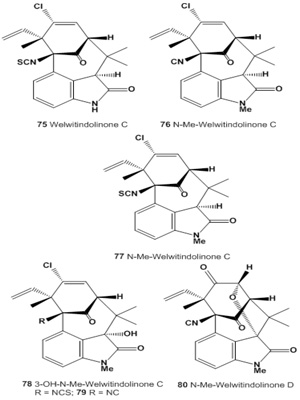 Table 4: Confirmed pharmacological and SAR activities.
Table 4: Confirmed pharmacological and SAR activities.
|
No |
Activity reviewed |
Activities confirmed (Pa) |
Additional predicted activities (Pa*) |
|---|---|---|---|
|
66 |
Not studied |
- |
Antineoplastic (0,743) Urolithiasis treatment (0,611) Antifungal (0,597) Anti-Plasmodium (0,534) |
|
67 |
Not studied |
- |
Antineoplastic (0,792) Urolithiasis treatment (0,598) Antifungal (0,501) |
|
68 |
Not studied |
- |
Antineoplastic (0,743) Urolithiasis treatment (0,611) Antifungal (0,597) Anti-Plasmodium (0,534) |
|
69 |
Not studied |
- |
Antineoplastic (0,600) Antifungal (0,485) Immunomodulator (HIV)0,501 |
|
70 |
Not studied |
- |
Anti-Plasmodium (0,707) Antiprotozoal (0,675) Antineoplastic (0,698) Antieczematic (0,548) Immunomodulator (HIV) (0,611) |
|
71 |
Not studied |
- |
Antineoplastic (0,739) Urolithiasis treatment (0,687) |
|
72 |
Not studied |
- |
Antineoplastic (0,583) |
|
73 |
Antineoplastic Antimitotic |
Antineoplastic (0,454) |
Antineoplastic (0,559) |
|
74 |
Not studied |
- |
Antineoplastic (0,583) |
|
75 |
Cytotoxic |
Antineoplastic (0,546) |
Anti-Plasmodium(0,714) Antiprotozoal (0,714) |
|
76 |
Antineoplastic Antimitotic |
Antineoplastic (0,480) |
Anti-Plasmodium (0,779) Antiprotozoal (0,775) Prostate disorders treatment (0,552) Allergic conjunctivitis treatment (0,539) |
|
77 |
Not studied |
- |
Antiprotozoal (0,676) Prostate disorders treatment (0,529) Allergic conjunctivitis treatment (0,511) |
|
78 |
MDR-reversing- activity |
Not predicted by the current PASS version |
Antineoplastic (0,663) Anti-Plasmodium (0,602) Antiprotozoal (0,596) |
|
79 |
Not studied |
- |
Anti-Plasmodium (0,733) Antiprotozoal (0,705) Antineoplastic (0,699) Prostate disorders treatment (0,506) |
|
80 |
Not studied |
- |
Antiprotozoal (0,763) Anti-Plasmodium (0,677) Antiinflammatory (0,668) Antineoplastic (0,579) |
*Activities with Pa > 0.5 are only shown.
CONCLUSION:
Isocyano/isothiocyanato metabolites are rare group of Ncontaining natural compounds. They are mainly discovered in microorganisms and plants, and have also been detected in some marine species. Little information is known about biological activities of these metabolites. Nevertheless, reported activities for isolated compounds have shown strong antineoplastic, antifungal, antibacterial, anti-mycobacterial, antiprotozoal and others activities. The widest spectra of pharmacological activities are exhibited by isolated alkaloids and/or their synthesized derivatives. Therefore, synthetic methodologies have been investigated in recent years, as this is a growing field of interest for chemists, biologists and pharmacologists.
ACKNOWLEDGMENT:
The work was partially supported (TAG and VVP) in the framework of the Russian State Academies of Sciences Fundamental Research Program for 2013-2020.
CONFLICT OF INTEREST:
The author confirms that this article content has no conflict of interest.
REFERENCES:
-
Scheuer PJ. (1992). Isocyanides and cyanides as natural products. Acc. Chem. Res. 25(10), 433-439.
-
Dembitsky VM and Levitsky DO. (2006). Acetylenic terrestrial anticancer agents. Nat. Prod. Commun. 1, 405-429.
-
Rothe W. (1950). New antibiotic. Phurmuzie. 5, 190-195.
-
Chang CWJ and Scheuer PJ. (1993). Marine isocyano compounds. Topics in Current Chemistry, Scheuer, PJ, Ed, Springer- Verlag, Berlin. 167, 33-87.
-
Jimenez C. (2001). Marine sulfur-containing natural products. Stud. Nat. Prod. Chem. 25(F), 811-917.
-
Avil's E and Rodriguez AD. (2010). Monamphilectine A, a potent antimalarial β-lactam from marine sponge Hymeniacidonsp: isolation, structure, semi-synthesis, and bioactivity. Org Lett. 12(22), 5290-5293.
-
Li CP and Blackman AJ. (1994). Cylindricines C-G, perhydropyrrolo[2,1-j]quinolin-7-one alkaloids from the ascidian Clavelina cylindrical. Australian J. Chem. 47, 1355-1361.
-
Li CP and Blackman AJ. (1995). Cylindricines H-K, novel alkaloids from the ascidian Clavelina cylindrical. Australian J. Chem. 48, 955-965.
-
Stratmann K, Moore RE, Bonjouklian R, Deeter JB, et al. (1994). Welwitindolinones, unusual alkaloids from the bluegreen algae Hapalosipohon welwitschii and Westiella intricate. Relationship to fischerindoles and hapalindoles. J. Am. Chem. Soc. 116, 9935-9942.
-
Moore RE and Patterson GML. (1988). Hapalindoles. US Patent: 4755610 A.
